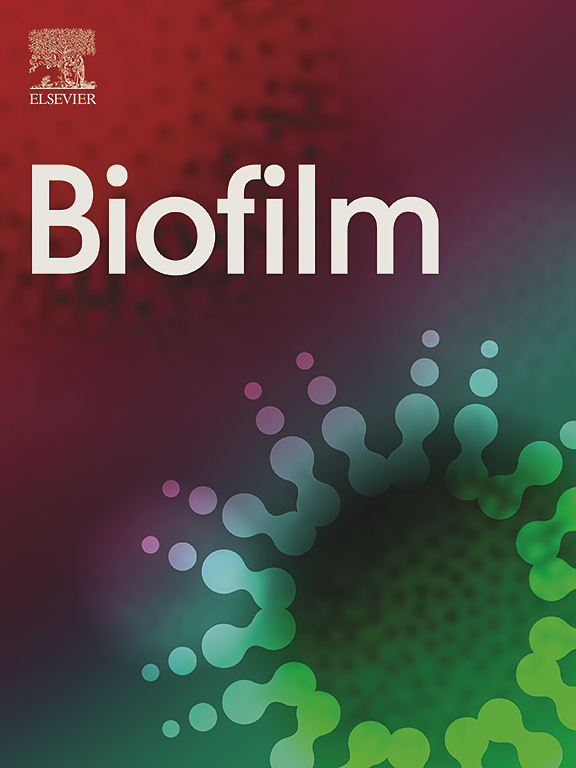Aspartic acid unveils as antibiofilm agent and tobramycin adjuvant against mucoid and small colony variants of Pseudomonas aeruginosa isolates in vitro within cystic fibrosis airway mucus
IF 4.9
Q1 MICROBIOLOGY
引用次数: 0
Abstract
Antibiotics are central to managing airway infections in cystic fibrosis (CF), yet current treatments often fail due to the presence of Pseudomonas aeruginosa biofilms, settling down the need for seeking therapies targeting biofilms. This study aimed to investigate the antibiofilm activity of aspartic acid and its potential as an adjuvant to tobramycin against P. aeruginosa biofilms formed by mucoid and small colony variant (SCV) tobramycin tolerant strain. We assessed the effect of aspartic acid on both surface-attached and suspended P. aeruginosa biofilms within CF artificial mucus and investigated the synergistic impact of combining it with non-lethal tobramycin concentrations. Our findings showed that aspartic acid inhibited planktonic P. aeruginosa without affecting its viability and prevented biofilm formation by hindering bacterial adhesion or interfering with EPS production, depending on the experimental conditions. In CF mucus, aspartic acid significantly reduced bacterial growth, with the highest inhibition observed when combined with tobramycin, showing notable effects against the mucoid and tolerant SCV strain. Despite these reductions, P. aeruginosa repopulated the mucus within 24 h of stress withdrawal. Additional strategies, including delayed tobramycin application and a second dose of co-application of aspartic acid and tobramycin were explored to address bacterial survival and recovery. Although none of the strategies eradicated P. aeruginosa, the second co-application resulted in slower bacterial recovery rates.
In conclusion, this study highlighted aspartic acid as an effective antibiofilm agent and demonstrated for the first time its potential as an adjuvant to tobramycin. The combined use of aspartic acid and tobramycin offers a promising advancement in CF therapeutics, particularly against P. aeruginosa biofilms formed by mucoid and SCV strains, mitigating their antibiotic resistance.
在囊性纤维化气道粘液中,天冬氨酸揭示了作为抗菌膜剂和托布霉素佐剂对抗铜绿假单胞菌粘液样和小菌落变体的作用。
抗生素是控制囊性纤维化(CF)气道感染的核心,但目前的治疗往往由于铜绿假单胞菌生物膜的存在而失败,这就需要寻找针对生物膜的治疗方法。本研究旨在探讨天冬氨酸的抗膜活性及其作为妥布霉素佐剂的潜力,以对抗由黏液和小菌落变异(SCV)妥布霉素耐药菌株形成的铜绿假单胞菌生物膜。我们评估了天冬氨酸对CF人工粘液中表面附着和悬浮的铜绿假单胞菌生物膜的影响,并研究了将其与非致死性tobramycin浓度联合使用的协同影响。我们的研究结果表明,天冬氨酸抑制浮游铜绿假单胞菌而不影响其生存能力,并通过阻碍细菌粘附或干扰EPS的产生来阻止生物膜的形成,这取决于实验条件。在CF粘液中,天冬氨酸显著降低了细菌的生长,与妥布霉素联合使用时,抑制作用最高,对粘液和耐受性SCV菌株有显著作用。尽管有这些减少,铜绿假单胞菌在应激退出后24小时内重新填充粘液。其他策略,包括延迟妥布霉素应用和第二次联合应用天冬氨酸和妥布霉素,探讨了解决细菌生存和恢复。虽然没有一种策略根除铜绿假单胞菌,但第二次联合应用导致细菌回收率较慢。总之,本研究强调了天冬氨酸是一种有效的抗生物膜剂,并首次证明了其作为妥布霉素佐剂的潜力。天冬氨酸和托布霉素的联合使用为CF治疗提供了一个有希望的进展,特别是针对由黏液和SCV菌株形成的铜绿假单胞菌生物膜,减轻其抗生素耐药性。
本文章由计算机程序翻译,如有差异,请以英文原文为准。
求助全文
约1分钟内获得全文
求助全文

 求助内容:
求助内容: 应助结果提醒方式:
应助结果提醒方式:


